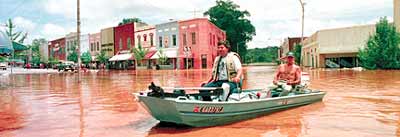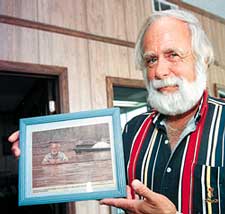
 |
| Danny Gilleland/The Macon Telegraph |
| In this file photo, rescue workers guide their boat through downtown Montezuma during the Great Flood of '94. |
Flood has taught town to thrive
By
Mara Shalhoup
The Macon Telegraph
MONTEZUMA - Marks of progress have replaced the watermarks of a once-submerged city.
On South Dooly Street, where a piece of rope was tied 13 feet up a pole to gauge the rising water, brick sidewalks have replaced torrents of mud. Slime and mildew have retreated under fresh paint and new tiles. A park has grown out of a dirt lot.
The town gutted by the Great Flood of '94 has been replaced by a community improved by it.
"I'm not sure that,
without the flood, we'd still be here," said Montezuma Mayor Preston
Williams. "It was a wake-up call for us. People during that time
of disaster became more involved, more appreciative of what they have."
 |
|
| Danny Gilleland/The Macon Telegraph | |
| Lloyd Swartzentruber, Georgia coordinator for the Mennonite Disaster Service, recalls the work his team of volunteers did during the flood. | |
Five years ago, floodwaters tried to carry Montezuma away. Instead, its citizens stood in the current's path. They demanded improvements that, without the flood, would have been impossible.
Their battle cry still rings.
"At the time, everybody was mad," said Carl Adams, owner of Cotton States Insurance of Montezuma. "(Downtown merchants) wanted to fight back, and we didn't know who to fight back at."
The business owners traded their anger for determination.
Of the 104 local stores damaged by the flood, 90 percent have reopened, according to City Manager David Peaster.
"Across the board, it's been a healthy recovery," Peaster said.
Adams was one of the fighters. He and his family saved $20,000 worth of phones, computers and copy machines in 20 minutes. Then the flood forced them out of their South Dooly Street store, leaving $80,000 of damage behind it.
He was not alone.
The citywide destruction to homes and businesses, estimated to total $13 million, netted $14 million in grants from state, federal and private agencies, Peaster said.
Part of that money was allotted because some flooded businesses were eligible for the National Register of Historic Places. The state's Historic Preservation Division and other state and federal agencies awarded Montezuma nearly $3 million to salvage the town's historic character.
By August 1997, many businesses were operating under new roofs and behind renovated facades. A year later, the shops were graced by old-fashioned sidewalks and street lamps.
"I definitely think Montezuma made the best of it," said Caren Allgood, who was hired by the city to oversee the historic revitalization downtown. "But at the time, when you saw the looks of desperation on people's faces, there was nothing good about it."
The first wave of work was dirty. There were bins of rotted food to haul away, 250,000 decomposed chickens to dispose of and a cake of red clay to chisel.
But there was help.
"I hated to see Montezuma go down the tubes," said Lloyd Swartzentruber, Georgia coordinator for the Mennonite Disaster Service. "So I put my shoulders to the harness."
More than 100 area Mennonites joined forces with volunteers from four states, forming a 400-strong labor force.
They launched boats into the streets and carried inventory from stores. They stacked sandbags at the Flint River, which later crested six feet above flood level. They fed as many as 1,000 people per day and brought 10,000-gallon tankers of drinking water to town. They buried chickens.
"The city called me," Swartzentruber said, "and I called my people."
But despite immediate emergency relief and long-term cosmetic improvements, flood recuperation is not complete today.
"It was the best thing to happen to this city, citywide," said city clerk Joyce Hardy. "But a lot of people were hurt in the process."
Many businesses were
not compensated for loss of their inventory or structural damage to interiors.
 |
|
| Danny Gilleland/The Macon Telegraph | |
| Jackie Kiff, owner of Montezuma Motor Co., holds a 1994 photo of himself chest deep in water. Kiff suffered the greatest financial loss of any Montezuma business owner. | |
Jackie Kiff, owner of Montezuma Motor Co., suffered the greatest financial loss of any Montezuma businessman. Although 42 destroyed vehicles had been insured by Ford, Kiff's losses topped $400,000 in parts, tools, inventory and damage to the building.
"One minute it was water in the street, and the next it was knee-deep in the showroom," said Kiff, laughing heartily.
He wasn't laughing then, however.
A $25,000 interest-free loan offered to flood-damaged businesses hardly put a dent in Kiff's devastation. Kiff absorbed his losses, and he and his employees rebuilt the business. About 10 weeks after the flood, the doors of Montezuma Motor Co. reopened.
"When you help put something back together like that, it's a lot more meaningful to you," Kiff said. "It's like a fresh start."
For some other downtown merchants, starting over wasn't as easy.
Leroy Barker, who used to run Barker's Bait & Tackle on South Dooly Street, lost his entire $150,000 inventory.
"Every nickel we made for five years went into that store," Barker said. "And we lost it in 20 minutes."
But Barker doesn't measure the cost of the flood in dollars, and it wasn't the lack of money that prevented his shop's rebirth.
Three months into the clean-up process, Barker walked into the store to find his older brother Melvin dead, poisoned by the fumes from two gas-driven generators.
"They just got him before he realized it," Barker said. "Since then, every time I walked through the door, I saw him there on the floor."
Unable to continue his shop's restoration, Barker moved the store out of downtown.
"It's taken a lot to come back, and it might be better for the downtown in the long run," Barker said. "But you can lose a lot that you can never bring back."
Hettie Oliver, who reopened her business in Barker's old location, first believed she was among those who had suffered permanent losses.
After Oliver glimpsed the damage to her dry-cleaning business, she said she admitted defeat. Macon County Cleaners was under four feet of water. Her entire inventory was lost, leaving piles of limp clothing and wires of ruined machinery.
But like two other shops off East Railroad Street, hers was purchased by the Federal Emergency Management Agency. FEMA ruled that none of the three businesses in that area could reopen at its location because it was within the flood plain, and the agency helped pay for the businesses to move.
Oliver was able to reopen six months later in the busier part of downtown.
"It sure did help us make a better living," she said.
She still has loans to repay from the flood. But where there were obstacles, Oliver discovered opportunities.
"At first it seemed horrible, but most of us were blessed," she said. "The devil came in and made it seem bad, but God made it good."